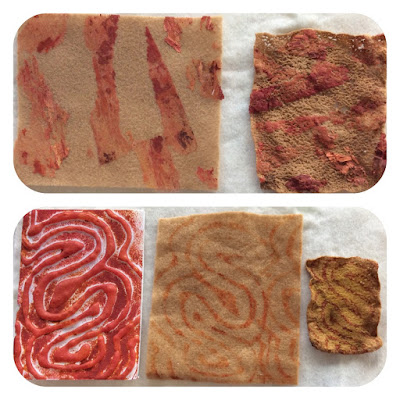We have worked with commercial felt in past sessions, but in
our session in May we focused entirely on commercial felt squares and the
multitude of ways it could be manipulated, embellished, stitched and most
importantly, how it distressed/melted with our heat guns.
Felt comes in a variety of colours and also as printed or
embossed felt. The printed felt is quite fun to use and adds an element of
extra colour to the piece. We did not try embossed felt, but it is available at
Michael’s here in Canada. If you are a little more on the diva side, felt also
comes flocked and glittered.
 |
| Printed felt, left. Hand cut petals of printed felt, heat distressed and assembled with a brad. Add a pin backing and you have a great brooch to wear. |
 |
| Printed felt, stitched and heat distressed. |
One of the ways we altered the look of the felt before
stitching and melting was with the use of commercial and handcrafted stencils
and stamps.
 |
| Jan, commercial stencil, left. Printed with metallic paint, right. |
 |
| Gillian, several techniques on all pieces. |
 |
| Variations on a theme, Commercial flower stencil. Couched yarns. |
 |
| Glue gun glue on foam core, left, stamp cut from a shoe insole, top right. Bottom right, stamp made from commercial, sticky backed foam stickers. |
If you want to maintain some structure with your piece before
melting, you can stitch on the felt beforehand. This ensures that your piece
will not fall apart. We tried both cotton and polyester threads and both seemed
to work.
 |
| Diane, Stitched and distressed. |
 |
| Nan, Stitched and distressed. |
If you own, or have access to a Sizzix™ or similar die
cutting machine you can cut shapes with your Sizzix™ and then heat distress
them with your heat gun. Both craft embossing and industrial heat guns work
well, you just need to test beforehand how much heat you need to use to melt
your felt.
 |
| Leaves cut with a Sizzix die and then heat distressed. |
Many synthetic fabrics will distress/melt with a heat gun.
While we mostly focused on the poly felt, by Kunin™ and Creatology™. Both are widely available at Michael’s and
most of the dollar stores. Karen did try some polar fleece and it seemed to
work very well.
 |
| Karen, adding elements to a denim piece, left. Heat distressed polar fleece, right. |
Another way to embellish your piece is to print an image onto fusible web and then iron it onto your felt. Then you can be as creative as you want with stitching and heat distressing.
 |
| Chris, Image on fusible web transferred by ironing to the felt, left. Stitched and heat distressed, right. |
While we were using the 9” by 12” inch squares of felt, I guess
they really should be called rectangles J, felt
is also availed in larger precut pieces and by the yard/metre off the bolt at
your local fabric store. Just think of the possibilities with a very large
piece of felt.
ECO Alesrt! You should also feel
good about using felt as a crafting item as it is mostly made from 100% post- consumer recycled and BPA-free plastic
bottles and produces a high-quality fibre at a very modest price.
Until next time, have Fun with Felt. Meredith and Jan









